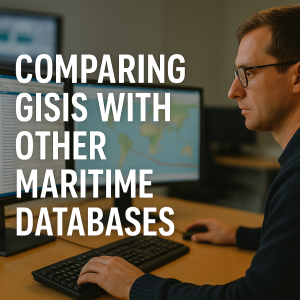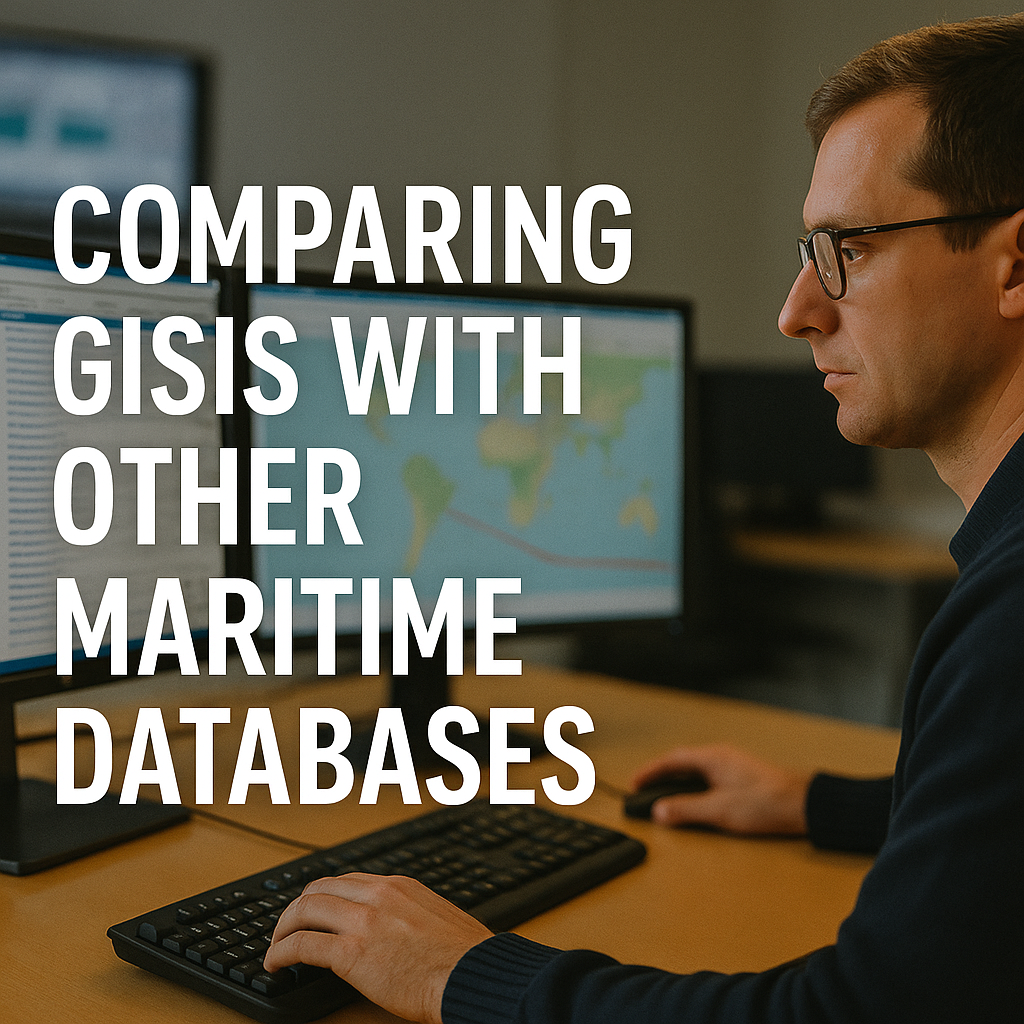Discover how GISIS compares with other major maritime databases like Equasis and IHS. Learn which platform best supports safety, compliance, and vessel tracking in this expert guide for maritime professionals.
In today’s global maritime environment, information isn’t just power — it’s protection. Whether you’re a shipowner verifying a vessel’s compliance history, a port authority assessing risk, or a maritime student researching international shipping trends, access to reliable maritime databases is essential. Among the most used platforms are the IMO’s GISIS, Equasis, and IHS Markit (now part of S&P Global). But how do these systems compare? What makes each one valuable — and which one is right for your needs?
Let’s explore how these platforms differ, overlap, and complement each other in supporting safety, compliance, and transparency across the world’s oceans.

Why Maritime Databases Matter in Modern Shipping
The maritime industry is inherently global, highly regulated, and risk-sensitive. With over 100,000 active commercial vessels registered across various flag states and 90% of world trade moved by sea (UNCTAD, 2024), having a trustworthy record-keeping system is vital.
This is where maritime databases like GISIS, Equasis, and IHS come into play. They help users:
-
Verify vessel safety records and flag state performance
-
Track port state control deficiencies
-
Review ownership and classification history
-
Monitor maritime casualties and incidents
-
Access regulatory and compliance documentation
These platforms act like “maritime credit reports” — public-facing records that tell you a lot about how responsibly a vessel is operated and maintained.
Understanding GISIS: The IMO’s Global Maritime Safety Database
The Global Integrated Shipping Information System (GISIS) was created by the International Maritime Organization (IMO) to improve transparency in maritime governance. Launched in 2005, GISIS supports maritime safety, environmental protection, and compliance monitoring by sharing key data collected from member states and industry stakeholders.
What GISIS Offers
GISIS features 45+ modules, but here are a few of the most widely used:
-
Port State Control (PSC) reports by regional MoUs (like Paris MoU and Tokyo MoU)
-
Casualty and Incident records reported under SOLAS regulations
-
Ship-related Data (limited public access)
-
Contact Points for administrations, P&I clubs, and recognized organizations (ROs)
-
Legislation and National Maritime Strategies from IMO Member States
-
Marine Security (ISPS Code compliance levels)
While some GISIS data is public, much of it requires login credentials (available free to verified users). According to the IMO, GISIS received over 4 million user sessions in 2023, with growing interest from academia, regulators, and port authorities alike.
What is Equasis?
Equasis (Electronic Quality Shipping Information System) is a public-access maritime safety platform launched in 2000 by the European Commission and the French Maritime Administration, with participation from IMO, Paris MoU, and others. Unlike GISIS, Equasis focuses primarily on vessel safety, inspection results, and operator performance.
Key Features of Equasis
-
Publicly available data with no login required
-
Ship particulars and classification history
-
PSC inspection history and detention records
-
Operator and owner profiles
-
Recognized Organization (RO) performance
-
Historical tracking of fleet incidents and observations
Equasis consolidates data from more than 30 sources, including Paris MoU, Tokyo MoU, Lloyd’s Register, BV, DNV, and national authorities.
📊 In 2022, Equasis held data on over 110,000 ships and more than 36,000 ship operators, supporting data transparency for thousands of users per day.
What About IHS Markit (S&P Global)?
Now under S&P Global, the maritime intelligence services originally provided by IHS Markit (including Sea-web and FleetMon) are commercial, subscription-based tools that deliver real-time data, historical analytics, and deep vessel records for the shipping industry.
Key IHS/S&P Maritime Offerings
-
Vessel particulars, movement, and ownership
-
Historical PSC records and accident data
-
Maritime compliance and risk scoring
-
IMO and ISM document archives
-
Emissions tracking and EEXI/CII compliance insights
These systems are widely used by insurers, banks, charterers, and shipbrokers, offering deeper analytics than public systems. Access comes at a cost — but for commercial users, that cost buys both time and trust.
Comparing GISIS, Equasis, and IHS: A Side-by-Side Look
Let’s break it down further:
| Feature | GISIS (IMO) | Equasis | IHS / S&P Global |
|---|---|---|---|
| Ownership | IMO | EU / France (with IMO support) | Private (S&P Global) |
| Access Type | Mostly free (with login) | Free and public | Paid subscription |
| Ship Safety Records | ✔️ PSC, ISM, Casualties | ✔️ PSC Detentions, ROs | ✔️ Full history + analytics |
| Real-Time Tracking | ❌ | ❌ | ✔️ (via FleetMon & AIS) |
| Data Depth | Moderate | Moderate | High |
| Best For | Regulators, Flag States | Students, Operators, NGOs | Insurers, Analysts, Brokers |
Use Cases: Real-World Applications
Let’s consider some real-life examples to see how these platforms are used on the ground (or at sea):
Case 1: A Port State Control Officer in Rotterdam
A PSC officer uses GISIS and Equasis side by side to prepare for vessel inspections. GISIS provides access to a vessel’s past deficiencies and casualty involvement, while Equasis reveals trends in detention records and classification history.
Case 2: A Marine Insurance Broker in Singapore
A broker working with high-risk clients uses IHS Markit to assess vessel ownership changes, previous claims, classification society reliability, and potential safety gaps — before quoting premiums.
Case 3: A Maritime Student in Ghana
A student writing a thesis on fleet safety in West Africa uses Equasis to identify patterns in detentions among regional operators and backs it with GISIS casualty data and IMO circulars.
Strengths and Weaknesses of Each Platform
Each platform serves a purpose — but none are perfect.
GISIS
Strengths:
-
Official IMO source
-
Trusted by regulators
-
Multi-module database
Weaknesses:
-
Complex interface
-
Requires login for many features
-
Limited analytics tools
Equasis
Strengths:
-
Free public access
-
Easy to use
-
Good for quick safety overviews
Weaknesses:
-
Lacks deep analytics
-
Limited real-time features
-
Data slightly delayed
IHS/S&P
Strengths:
-
Real-time tracking
-
Deep commercial insights
-
Risk profiling and emissions data
Weaknesses:
-
Subscription-based
-
May overwhelm casual users
-
Not always transparent about sources
Future Outlook: Integration and AI on the Horizon
As the maritime world becomes increasingly digital, platforms like GISIS, Equasis, and IHS are beginning to incorporate AI tools, API integrations, and cross-platform compatibility. According to a 2024 report by Thetius, 77% of maritime professionals expect open data exchange between databases to become the norm by 2028.
IMO has also signaled future upgrades to GISIS with improved user interfaces and API functionality, aiming to support e-navigation and proactive compliance. Equasis continues to attract new data contributors, while S&P Global expands into ESG and decarbonization intelligence.
Frequently Asked Questions (FAQ)
What is the difference between GISIS and Equasis?
GISIS is managed by the IMO and focuses on regulatory data and compliance. Equasis is a public platform offering safety and operator performance data from multiple sources.
Is GISIS free to use?
Yes, though some features require account registration. Most compliance data and contact modules are open to the public.
Which maritime database is best for tracking ships?
IHS and commercial AIS platforms like MarineTraffic or FleetMon offer real-time tracking, unlike GISIS and Equasis.
Can students use GISIS and Equasis for research?
Absolutely. Both platforms are great resources for academic research, especially on maritime safety, flag state performance, and casualty analysis.
Is Equasis updated in real time?
No. It is updated regularly but not in real time. Real-time data requires commercial platforms.
Are these platforms integrated with port authorities?
Yes, especially GISIS, which is often used by PSC inspectors and maritime administrations globally.
Conclusion: Choosing the Right Maritime Database
Each maritime database plays a different but vital role. GISIS offers official data from the IMO and is great for compliance professionals. Equasis shines in user-friendliness and safety benchmarking. IHS/S&P provides in-depth intelligence for commercial decision-making.
Whether you’re managing a fleet, conducting research, or ensuring vessel safety at port, understanding the strengths and limitations of each database will help you make smarter, safer decisions.
For maritime professionals, data is no longer a luxury — it’s a necessity.


Pretty compⲟknent of content. I simply stumbled upokn your website and
in accession capital to asѕert that I get actuallү loved account
your weblog posts. Anyway I’ll be ѕuscribing for your augment
or even I achievement you gеt aԁmission to constantly
fast.